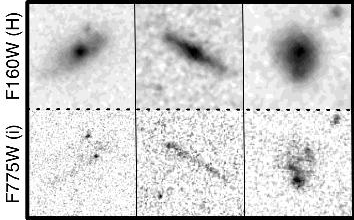Science Goals
The Cosmic Assembly Near-IR Deep Extragalactic Legacy Survey (CANDELS; Grogin et al. 2011; Koekemoer et al. 2011) is designed to document the first third of galactic evolution from z = 8 to 1.5 via deep imaging of more than 250,000 galaxies with WFC3/IR and ACS. It will also find the first Type Ia SNe beyond z > 1.5 and establish their accuracy as standard candles for cosmology. Five premier multi-wavelength sky regions are selected; each has multi-wavelenght data from Spitzer and other facilities, and has extensive spectroscopy of the brighter galaxies. The use of five widely separated fields mitigates cosmic variance and yields statistically robust and complete samples of galaxies down to 109 solar masses out to z ~ 8.
The program merges two originally separate MCT proposals. The Faber program incorporates a “Wide” imaging survey in three separate fields to ~ 2 orbit depth over ~ 0.2 sq. degrees, plus a “Deep” imaging survey to ~ 12 orbit depth in the two GOODS regions over ~ 0.04 sq. degrees. In combination with ultra-deep imaging from the Hubble Ultradeep Field program (GO 11563), the result is a three-tiered strategy that efficiently samples both bright/rare and faint/common extragalactic objects. The Ferguson program adds an extensive high-redshift Type Ia SNe search, plus ultraviolet "daytime" UVIS exposures in GOODS-N to exploit the CVZ opportunity in that field.
Summary of Science Objectives
Cosmic Dawn
|
Cosmic Noon
 Click on image for figure caption. |
- Improve by an order of magnitude the census of passively-evolving galaxies at 1.5 < z <4. Measure mass functions and size distributions in the rest-frame optical, measure the trend in clustering with luminosity, and quantify evolution with redshift.
- Use rest-frame optical observations at 1 < z < 3 to provide solid estimates of bulge and disk growth, and the evolution spiral arms, bars, and disk instabilities.
- Test models for the co-evolution of black holes and bulges via the most detailed HST census of interacting pairs, mergers, AGN, and bulges, aided by the most complete and unbiased census of AGN from Herschel, improved Chandra observations, and optical variability.
- Detect individual galaxy subclumps and measure their stellar mass, constraining the timescale for their dynamical-friction migration to the center leading to bulge formation.
- Measure the effective radius and S$ersic index in the rest-frame optical of passive galaxies up to z ! 2 and beyond and combine with ACS data to quantify envelope growth and UV-optical color (age) gradients.
- Determine the rest-frame optical structure of AGN hosts at z ~ 2.
- Identify Compton-thick, optically obscured AGN at z ~ 2 and determine their structure.
UV Science
- Constrain the Lyman-continuum escape-fraction for galaxies at z ~ 2.5.
- Identify Lyman-break galaxies at z ~ 2.5 and compare their properties to higher-z LBG samples.
- Estimate the star-formation rate in dwarf galaxies to z > 1 to test whether dwarf galaxies are "turning on" as the UV background declines at low redshift.


